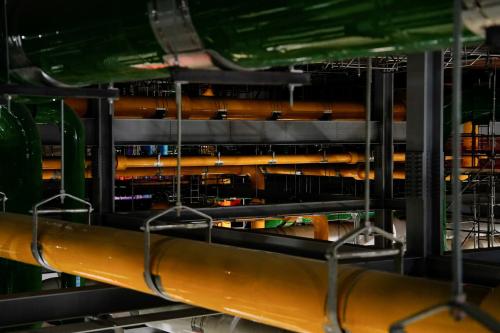Across the country, from Virginia to Michigan to Arizona, tech companies are pouring billions of dollars into new data center projects needed to store and manage digital information amid the rise of artificial intelligence (AI). Meanwhile, state and local governments are enticed by projected increases in economic output, job creation, property tax revenue, and more that may accompany such projects. In some communities, leaders are practically tripping over themselves to lure more tech investment as part of the country’s expanding AI boom, whether by offering tax incentives or scrambling to approve permits.
But amid this AI-fueled gold rush, more leaders are beginning to pay attention to the short- and long-term natural resource concerns, especially around all the water needed to keep data centers running. And even beyond the water needed to support data centers, public and private leaders increasingly need to view data centers in light of larger regional plans and priorities around water infrastructure investment and economic development.
Building a new facility and pledging economic impact mean little without sustainably incorporating water resources into ongoing operations. While land and energy are also enormous inputs, water is a fundamental ingredient to keep servers and other equipment in data centers reliably cool. A typical data center uses 300,000 gallons of water each day (equivalent to the demands of about 1,000 households), but large data centers can use an estimated 5 million gallons of water each day, equivalent to the needs of a town of up to 50,000 residents. Moreover, projections show water used for cooling may increase by 870% in the coming years as more facilities come online. These direct water needs also do not include the indirect needs required for energy generated offsite or involved in manufacturing software components.
To be sure, technological innovations are evolving rapidly to reduce water use. The exact amount of water needed varies widely depending on the facility, including whether it uses a closed-loop cooling system, which can reduce freshwater use by up to 70%. Other design improvements, such as air cooling and immersion cooling, can remove heat and help limit water use. And taking advantage of renewable energy sources, including onsite solar installations, can coincide with these upgrades to boost overall sustainability. But the resource challenge is still a vexing concern in many regions.
The result is a complex challenge not only facing tech firms and economic development leaders, but also the individual water systems responsible for providing service. Increasingly, more systems in more places are grappling with data centers’ water impacts—and those of an AI-driven world more generally—including significant and ongoing water use; expanded infrastructure costs such as new distribution lines to reach exurban facilities; and other regulatory and financial pressures. Even as data centers may depend more on water reuse technologies or onsite water sources, that does not change the fact that water stresses are still hitting different regions with greater frequency and intensity. In addition, the concentration of existing or potential facilities means some regions are facing more intense demands, particularly water-stressed areas in the West and Southwest.
Ordinarily, many of the country’s water infrastructure concerns are out of sight and out of mind when it comes to regional economic development planning. Aging pipes, treatment plants, and other systems are weighing heavily on local water systems, but many businesses (and households, for that matter) do not think about these physical challenges outside of their rising water bills or a sudden service disruption. Increased flood, fire, and drought risk, combined with new regulatory pressures around stormwater runoff and other contaminants, further compound these physical pressures. The price tag associated with needed repairs is also surging, including an estimated $744 billion in drinking water and wastewater improvements over the next two decades. And many local water systems are addressing these needs with fewer staff, fewer federal resources, and less technical, financial, and managerial capacity overall.
Addressing the water demands of AI and data centers needs to move beyond ad-hoc, site-specific concerns or clickbait-y headlines around the use of ChatGPT. These technological and economic shocks are coinciding with an enormous number and variety of prevailing water infrastructure concerns across the country. Together, these challenges require more comprehensive planning and action among a cross-section of actors: tech firms, economic development organizations, and water systems, among others.
The challenge—and opportunity—is to address the growing footprints of data centers alongside mounting water infrastructure investment needs, especially at a regional level. The hyper-fragmentation and localization of water infrastructure demands overseen by more than 50,000 local water systems nationally requires more regional thinking and planning; doing so can help spread financial risk, build greater institutional capacity, and seize economic development opportunities. Out of necessity, some rural communities with particularly acute capacity constraints are considering such regional approaches, but leaders in larger urban regions are recognizing the benefits of formal and informal regional collaborations too. Joint water investment and economic planning have evolved over many decades in Las Vegas; emerging tech-focused efforts have taken root in Chicago; and other climate and workforce-driven regional plans and partnerships have evolved in markets ranging from New Orleans to San Francisco.
Leaders in these and other areas have demonstrated how regional approaches to water investment and economic development can take hold—and AI and data centers should be no exception. As part of industry cluster initiatives in Milwaukee, for instance, leaders have identified clear regional concerns and shared priorities to inform growth strategies and needed infrastructure improvements. As part of capital plans and budgets in data center hubs such as Loudoun County, Va., leaders have started to better measure and forecast tech-impacted infrastructure needs. And as part of climate action and resilience planning efforts in Austin, Texas, leaders have established regional tables to bring actors together, address workforce and economic development challenges, and chart strategies toward implementation.
Regional coordination can come in many different forms and happen for a variety of reasons, but one point is clear: Water leaders and economic development leaders are increasingly recognizing the benefits of working hand-in-hand more consistently and proactively. AI and data centers offer a prime opportunity for them to do so even more in the years to come.
-
Acknowledgements and disclosures
The author wishes to thank Megan Wright for excellent research assistance.
The Brookings Institution is committed to quality, independence, and impact.
We are supported by a diverse array of funders. In line with our values and policies, each Brookings publication represents the sole views of its author(s).




Commentary
AI, data centers, and water
A growing need for regional coordination amid economic development potential
November 20, 2025